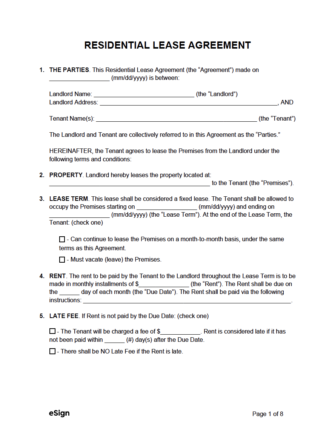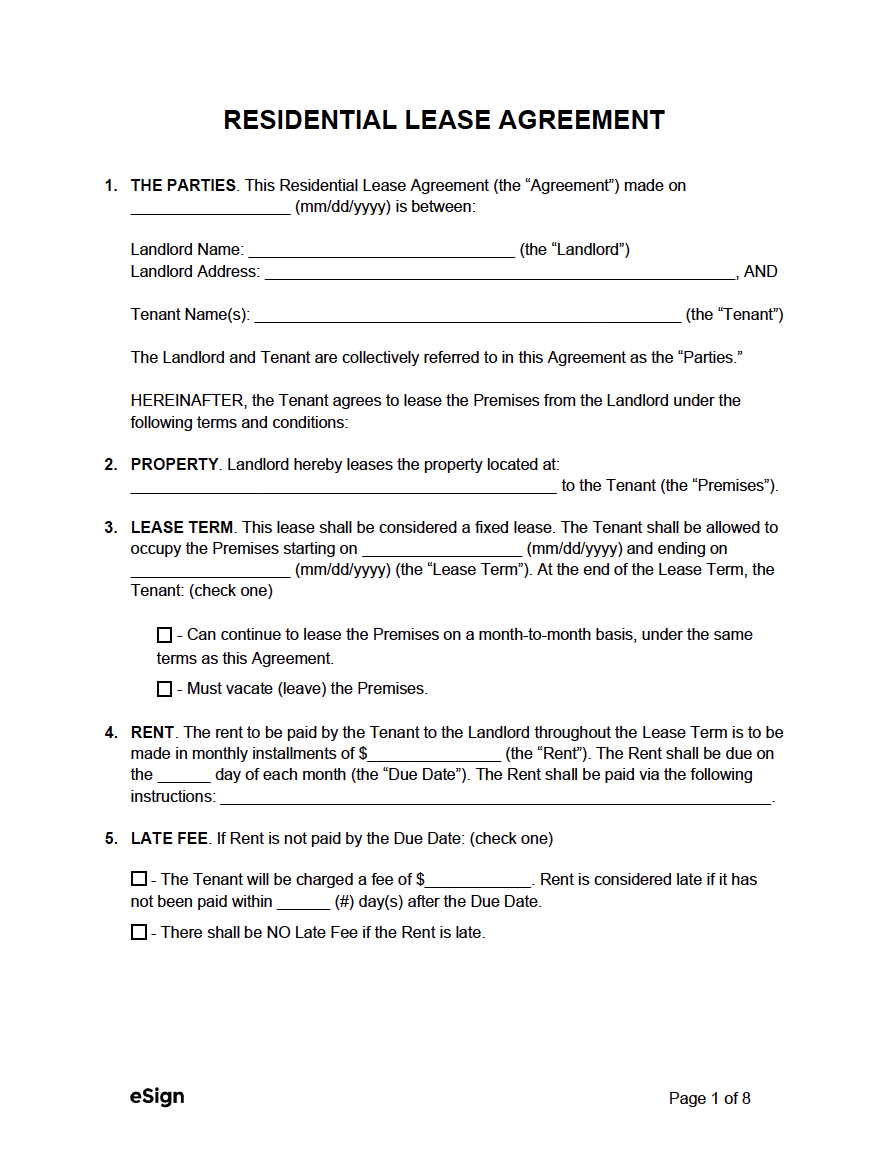By State
- Alabama
- Alaska
- Arizona
- Arkansas
- California
- Colorado
- Connecticut
- Delaware
- Florida
- Georgia
- Hawaii
- Idaho
- Illinois
- Indiana
- Iowa
- Kansas
- Kentucky
- Louisiana
- Maine
- Maryland
- Massachusetts
- Michigan
- Minnesota
- Mississippi
- Missouri
- Montana
- Nebraska
- Nevada
- New Hampshire
- New Jersey
- New Mexico
- New York
- North Carolina
- North Dakota
- Ohio
- Oklahoma
- Oregon
- Pennsylvania
- Rhode Island
- South Carolina
- South Dakota
- Tennessee
- Texas
- Utah
- Vermont
- Virginia
- Washington
- West Virginia
- Wisconsin
- Wyoming
By Type (4)
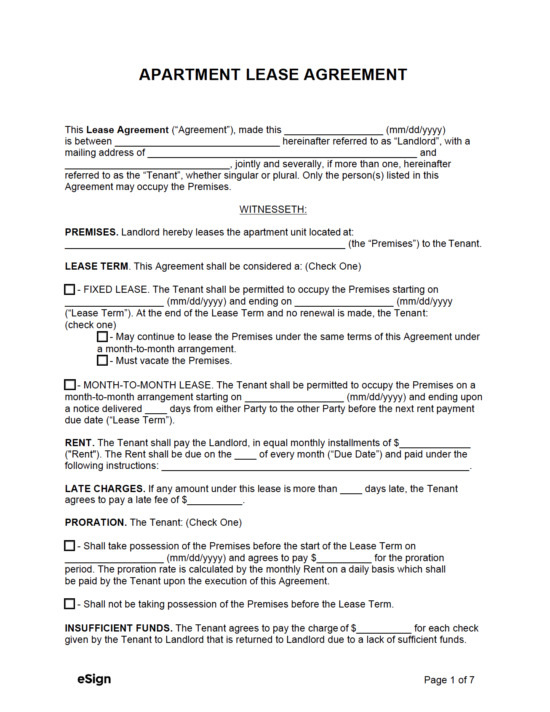 Apartment Lease Agreement – For renting out a duplex, triplex, studio, loft, and other apartment types. Apartment Lease Agreement – For renting out a duplex, triplex, studio, loft, and other apartment types.
Download: PDF, Word (.docx), OpenDocument
|
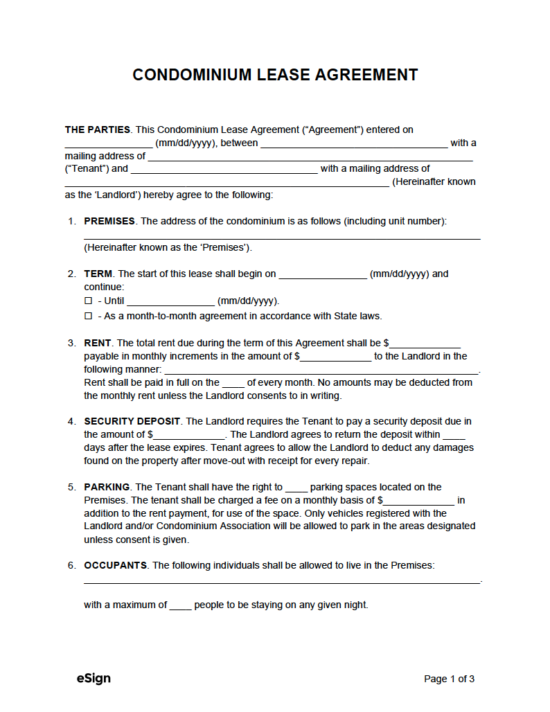 Condominium Lease Agreement – Allows condo owners a means of easily leasing their unit(s) when they are not in use. Condominium Lease Agreement – Allows condo owners a means of easily leasing their unit(s) when they are not in use.
Download: PDF, Word (.docx), OpenDocument
|
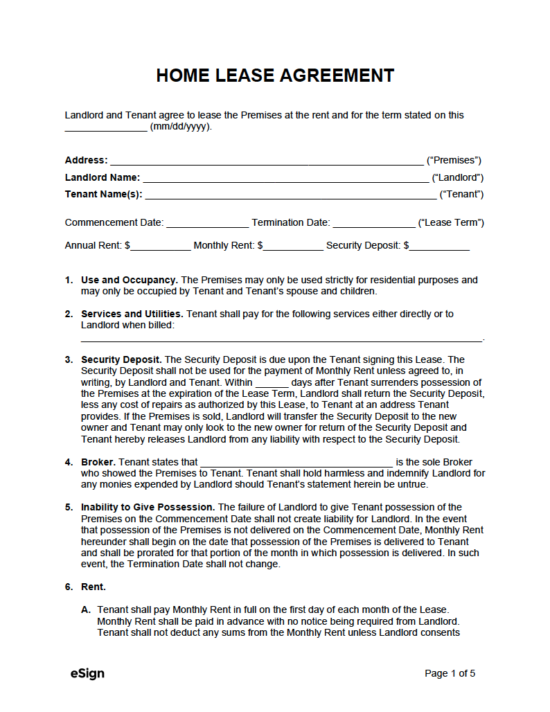 Home Lease Agreement – For leasing out an entire home to one (1) or more tenants. Home Lease Agreement – For leasing out an entire home to one (1) or more tenants.
Download: PDF, Word (.docx), OpenDocument |
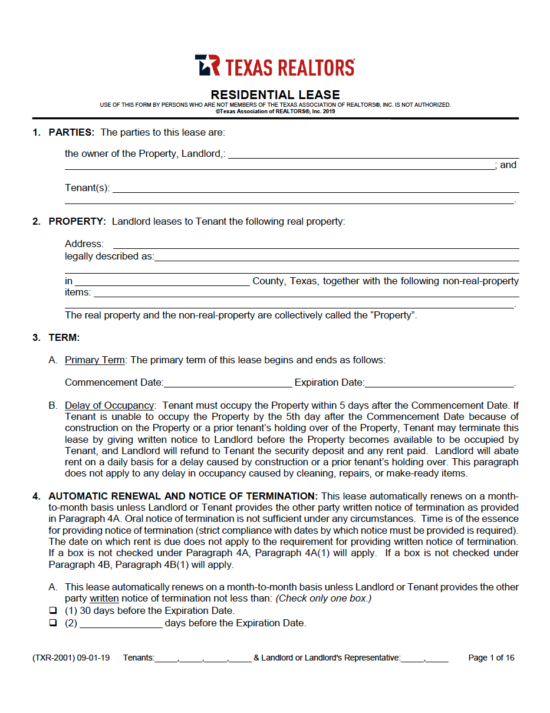 Realtor Lease Agreement – The official versions used by Realtors, specific to each state. Realtor Lease Agreement – The official versions used by Realtors, specific to each state.
Download: PDF |
Sample
RESIDENTIAL LEASE AGREEMENT
1. THE PARTIES. This Residential Lease Agreement (the “Agreement”) made on [MM/DD/YYYY] is between:
Landlord: [LANDLORD NAME] of [LANDLORD ADDRESS] (the “Landlord”), and
Tenant: [TENANT NAME(S)] (the “Tenant”)
The Landlord and Tenant are collectively referred to in this Agreement as the “Parties.” HEREINAFTER, the Tenant agrees to lease the Premises from the Landlord under the following terms and conditions:
2. PROPERTY. The Landlord hereby leases the property located at: [PROPERTY ADDRESS] to the Tenant (the “Premises”).
3. LEASE TERM. This lease shall be considered a fixed lease. The Tenant shall be allowed to occupy the Premises starting on [MM/DD/YYYY] and ending on [MM/DD/YYYY] (the “Lease Term”).
4. RENT. The rent to be paid by the Tenant to the Landlord throughout the Lease Term is to be made in monthly installments of $[AMOUNT] (the “Rent”). The Rent shall be due on the [#] day of each month (the “Due Date”). The Rent shall be paid via the following instructions: [RENT PAYMENT INSTRUCTIONS].
5. LATE FEE. If Rent is not paid by the Due Date: (check one)
☐ – The Tenant will be charged a fee of $[AMOUNT]. Rent is considered late if it has not been paid within [#] day(s) after the Due Date.
☐ – There shall be NO Late Fee if the Rent is late.
6. SECURITY DEPOSIT. As part of this Agreement, the Landlord requires a payment of $[AMOUNT] (the “Security Deposit”) for the faithful performance of the Tenant under the terms and conditions of this Agreement. The Security Deposit is required by the Tenant upon the execution of this Agreement. The Security Deposit shall be returned to the Tenant within [#] days after the end of the Lease Term, less any itemized deductions. This Security Deposit shall not be credited towards any Rent unless the Landlord gives their written consent.
7. OCCUPANTS. The Premises is to be occupied strictly as a residential dwelling with the following individual(s) in addition to the Tenant: (check one)
☐ – [OCCUPANT NAME(S)] (the “Occupant(s)”).
☐ – There are NO Occupant(s) in addition to the Tenant.
8. MOVE-IN INSPECTION. Before, at the time of, or shortly after move-in, the Landlord and Tenant agree to inspect the Premises and write any present damages or needed repairs on a move-in checklist.
9. FURNISHINGS. The Premises is: (check one)
☐ – Furnished (or will be furnished) with the following items: [IF FURNISHED, LIST ALL ITEM(S) HERE].
☐ – NOT furnished.
10. UTILITIES. The Landlord shall pay for the following utilities and services to the Tenant, with any absence being the Tenant’s responsibility: [LIST ALL LANDLORD-PAID UTILITIES].
11. PARKING. The Tenant is allotted [#] parking space(s) under the following conditions: [PARKING CONDITIONS/FEES]
12. PETS. The Tenant is: (check one)
☐ – Permitted to have [#] pet(s) on the Premises, ONLY consisting of (list pet types): [LIST ALL PERMITTED PET TYPE(S)].
☐ – NOT permitted to have pets of any nature on the Premises.
13. SMOKING POLICY. Smoking on the Premises is: (check one)
☐ – Permitted ONLY in the following area(s): [PERMITTED AREA(S)].
☐ – Prohibited on the Premises and all Common Areas.
14. SALE OF PROPERTY. If the Premises is sold during the Lease Term, the Tenant is to be notified of the new Owner’s contact details, and if there is a new Manager, their contact details for repairs and maintenance shall be forwarded. If the Premises is conveyed to another party, the new owner: (check one)
☐ – Has the right to terminate this Agreement by providing [#] days’ notice to the Tenant.
☐ – Does NOT have the right to terminate this Agreement.
15. NOTICES. Any notice sent by the Landlord or the Tenant to each other shall use the addresses entered in Sections 1 and 2, respectively.
16. ACCESS. Upon the beginning of the proration period or the start of the Lease Term, whichever is earlier, the Landlord agrees to give the Tenant access in the form of keys, fobs, cards, or any type of keyless security entry as needed to enter the common areas and the Premises. Duplicate copies of the access provided may only be authorized under the consent of the Landlord, and if any replacements are needed, the Landlord may provide them for a fee. At the end of this Agreement, all access provided to the Tenant shall be returned to the Landlord, a fee will be charged to the Tenant, or the fee will be subtracted from the Security Deposit.
17. RIGHT OF ENTRY. The Landlord shall have the right to enter the Premises during normal working hours by providing at least twenty-four (24) hours’ notice to inspect and make necessary repairs/alterations/improvements for any reasonable purpose. The Landlord may exhibit the Premises to prospective purchasers, mortgagees, or lessees upon reasonable notice.
18. NOISE. The Tenant agrees not to cause or allow any noise or activity on the Premises that might disturb the peace and quiet of another Tenant and/or neighbor. Said noise and/or activity shall be a breach of this Agreement.
19. GUESTS. There shall be no other persons living on the Premises other than the Tenant and any Occupant(s). Guests of the Tenant can stay on the Premises for periods not lasting more than forty-eight (48) hours unless otherwise approved by the Landlord in writing.
20. MAINTENANCE. At the Tenant’s sole expense, the Tenant will keep and maintain the Premises in a good, clean, and sanitary condition during the Lease Term and any renewal thereof.
21. GOVERNING LAW. This Agreement shall be governed by the laws of the state of [STATE NAME].
22. LEAD-BASED PAINT. The Premises (check one):
☐ – Was built before 1978. An attachment titled “Disclosure of Information on Lead-Based Paint and/or Lead-Based Paint Hazards” has been affixed to the Agreement and must be initialed and signed by the Parties.
☐ – Was NOT built before 1978.
23. ADDITIONAL PROVISIONS.
[ADD ANY ADDITIONAL TERMS AND CONDITIONS HERE (OPTIONAL)].
24. ENTIRE AGREEMENT. This Agreement contains all the terms agreed to by the Parties and may be modified or amended only by written agreement signed by the Landlord and Tenant. This Agreement replaces all previous discussions, understandings, and oral agreements. The Parties agree to the terms and conditions and shall be bound until the end of the Lease Term.
IN WITNESS THEREOF, the Parties have caused this Agreement to be executed on the day and year first above written.
Landlord’s Signature: _________________________ Date: [MM/DD/YYYY]
Printed Name: [LANDLORD PRINTED NAME]
Tenant’s Signature: _________________________ Date: [MM/DD/YYYY]
Printed Name: [TENANT PRINTED NAME]
Tenant’s Signature: _________________________ Date: [MM/DD/YYYY]
Printed Name: [TENANT PRINTED NAME]
